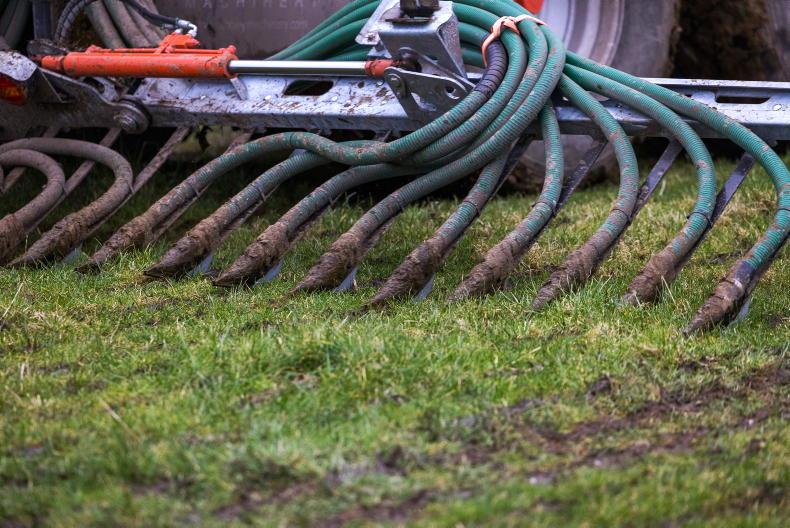Restrictions on slurry spreading will end this weekend for farmers in zone A, while farmers in zone B can apply slurry from Tuesday 16 January. For farms in zone C and in Northern Ireland, the slurry season opens on 1 February.
When it comes to spreading slurry in early spring, outlined are five things to keep in mind.
1. Working safely
Working with slurry is dangerous. Regardless of the time of year, always keep safety in mind.
Weather windows are limited in early spring, often creating a rush to ease pressure on tanks while ground conditions will carry machinery. That’s when accidents can happen.
Slurry gases are most potent during the first 10 minutes of agitating tanks, so stay out of sheds once mixing starts. Removing cattle directly above the tank being mixed is highly recommended.
Always cover openings to slurry tanks when leaving the yard to empty the tanker, or, when tending to other jobs. Keep children and pets well away for slurry mixing and filling points.
Ensure the PTO shaft on the tanker is properly covered. Always disengage the PTO when switching the vacuum pump from fill to spread.
Make sure the tractor can handle a full tanker and brake safely under load. Front weights may help with ballast. Finally, be careful when spreading on sloped ground.
2. Target swards with low covers
Target paddocks with low grass covers as these swards will be grazed towards the end of the first rotation.
This gives more time for slurry to be washed into the soil, improving grass utilisation once animals start grazing and reducing the risk of grass tetany.
3. Not all slurry has the same fertiliser value
Cattle, poultry and pigs on high meal levels produce slurry with a superior nutrient content than dry cows on a silage only diet.
Target the higher value slurries to silage swards or fields with lower P and K levels. Tanks with lower value slurry can be used to maintain fields with higher P and K levels.
4. Leave a gap between slurry and chemical fertiliser applications
On paddocks that get a combination of early slurry and chemical nitrogen, leave a gap of around one week between applications.
There can be an enzyme reaction that increases nitrogen losses if chemical fertiliser is applied too soon after slurry.
There is also a risk of overloading soils with nitrogen at a time of low grass growth. If lime spreading is planned, hold off for three to four weeks after applying slurry.
5. Spreading rates
Grass growth will struggle to hit double figures during January and February, so heavy applications of slurry during these months offers little benefit.
Instead, a light dressing around 1,500 to 2,000 gallons per acre will make greater use of slurry nutrients in early spring.
Higher spreading rates will over-supply nutrients, increasing the risk of run off into water courses and atmospheric losses.
Low emission slurry spreading equipment will also increase nitrogen availability and reduce the risk of nutrient run-off.
Read more
New slurry spreading rules for farms stocked above 130kg N/ha
Buying a new slurry tanker – the essential options
Restrictions on slurry spreading will end this weekend for farmers in zone A, while farmers in zone B can apply slurry from Tuesday 16 January. For farms in zone C and in Northern Ireland, the slurry season opens on 1 February.
When it comes to spreading slurry in early spring, outlined are five things to keep in mind.
1. Working safely
Working with slurry is dangerous. Regardless of the time of year, always keep safety in mind.
Weather windows are limited in early spring, often creating a rush to ease pressure on tanks while ground conditions will carry machinery. That’s when accidents can happen.
Slurry gases are most potent during the first 10 minutes of agitating tanks, so stay out of sheds once mixing starts. Removing cattle directly above the tank being mixed is highly recommended.
Always cover openings to slurry tanks when leaving the yard to empty the tanker, or, when tending to other jobs. Keep children and pets well away for slurry mixing and filling points.
Ensure the PTO shaft on the tanker is properly covered. Always disengage the PTO when switching the vacuum pump from fill to spread.
Make sure the tractor can handle a full tanker and brake safely under load. Front weights may help with ballast. Finally, be careful when spreading on sloped ground.
2. Target swards with low covers
Target paddocks with low grass covers as these swards will be grazed towards the end of the first rotation.
This gives more time for slurry to be washed into the soil, improving grass utilisation once animals start grazing and reducing the risk of grass tetany.
3. Not all slurry has the same fertiliser value
Cattle, poultry and pigs on high meal levels produce slurry with a superior nutrient content than dry cows on a silage only diet.
Target the higher value slurries to silage swards or fields with lower P and K levels. Tanks with lower value slurry can be used to maintain fields with higher P and K levels.
4. Leave a gap between slurry and chemical fertiliser applications
On paddocks that get a combination of early slurry and chemical nitrogen, leave a gap of around one week between applications.
There can be an enzyme reaction that increases nitrogen losses if chemical fertiliser is applied too soon after slurry.
There is also a risk of overloading soils with nitrogen at a time of low grass growth. If lime spreading is planned, hold off for three to four weeks after applying slurry.
5. Spreading rates
Grass growth will struggle to hit double figures during January and February, so heavy applications of slurry during these months offers little benefit.
Instead, a light dressing around 1,500 to 2,000 gallons per acre will make greater use of slurry nutrients in early spring.
Higher spreading rates will over-supply nutrients, increasing the risk of run off into water courses and atmospheric losses.
Low emission slurry spreading equipment will also increase nitrogen availability and reduce the risk of nutrient run-off.
Read more
New slurry spreading rules for farms stocked above 130kg N/ha
Buying a new slurry tanker – the essential options










SHARING OPTIONS